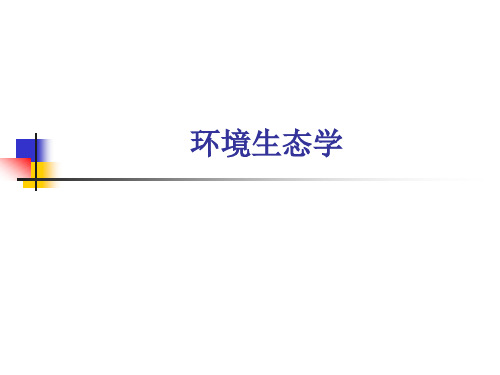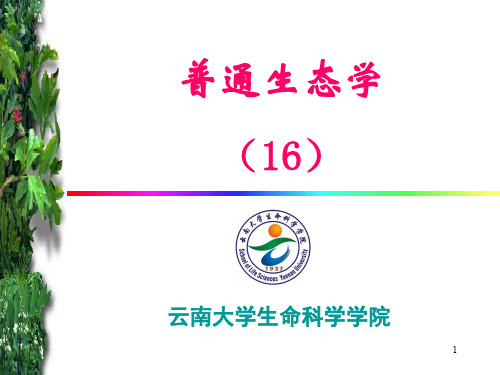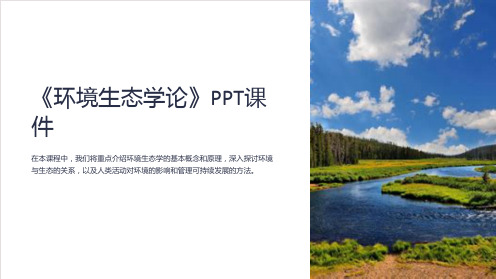《环境生态学Cha》PPT课件
合集下载
环境生态学课件PPT(共 63张)

的在短期内人群大量发病和死亡事件。(1马斯河谷2多诺拉3光
3.环境问题的第一次高潮(20世纪50—60年代)
环境问题的第一次高潮出现在20世纪50—60年代,当时环 境问题突出。自产业革命-1984年臭氧层空洞,“八大公害” 事件,是第一次环境问题高潮。
八大公害事件 :是指在世界范围内,由于环境污染而造成的
八次较大的轰动世界的公害事件。 公害事件:因环境污染造成
二.环境构成 环境包括自然环境和人工环境。
自然环境:
是人类出现之前就出现的,是人类目前赖以生存的自然条件和自然 资源的总称。是直接或间接影响到人类的一切自然形成的物质,能量和 自然现象的总体。
人工环境:
从狭义上: 来讲是指人类根据生产,生活,科研,文化,医疗等需要而创造的环
境空间,如人工气候室,无尘车间,温室,密封舱,各种建筑,人工园 林等。 从广义上:
2008。 5.尚玉昌 著《生态学概论》,北京大学出版社2003-2。 6.同济大学 编《城市环境保护》,中国建筑工业出版社。 7.毛文永 编《生态环境影响评价概论》,中国环境科学出版
社 1998-5。 8.周曦 编《生态设计新论》,东南大学出版社 2003-6。 9.《环境生态学》化学工业出版社 2003-8。 其他与生态学相关书目,特别须关注关于生态景观的书目。
三是由于上述原因造成生物资源的破坏,而导致生物多样性丰 富度的下降,大量物种灭绝或处于濒危境地。生物多样性的破坏 必然会导致人类的生存危机,人类对于这个问题严重性的认识还 远远不够。
二、环境问题的由来和发展
。 环境问题是随着人类生产力的发展而产生和加剧的
1.环境问题的萌芽阶段(工业革命以前) 农业和畜牧业出现以前,人类活动以生活活动为主,以生理代谢过程
2024版年度环境生态学课件PPT共63张大纲

生态风险的管理与应对措施
提出生态风险的管理和应对措施,包括风险预警、风险防范、风险 处置等,以及加强生态风险管理的建议。
26
07
环境生态学的未来发展
2024/2/3
27
环境生态学面临的挑战与机遇
挑战
全球气候变化、生物多样性丧失、环境污染与生态破坏等问题日益严重,对环境生 态学提出了更高要求。
机遇
和岩石圈上层。
2024/2/3
生态系统
指在一定空间内,生物群落与其非 生物环境之间通过物质循环、能量 流动和信息传递而形成的相互作用、 相互依存的统一整体。
生物群落
指生活在一定区域内所有生物种群 的集合体,它们之间以及它们与环 境之间彼此影响、相互作用。
8
生物与环境的关系
环境对生物的影响
环境为生物提供生存所需的物质和能量,同时 影响生物的生长、发育和繁殖等过程。
案例分析
结合实际案例,分析生态保护和恢复的成功实践,如退耕还林、湿 地保护等。
24
生态工程与技术
1
生态工程的概念与特点
介绍生态工程的基本概念和特点,强调其在解决 环境问题、促进可持续发展中的重要作用。
2
生态工程的技术与方法
详细介绍生态工程的技术和方法,包括生态修复 技术、生态农业技术、生态园林技术等,以及其 在实践中的应用。
2024/2/3
16
群落的动态与演替
群落动态
包括季节变化、年际变化以及长 期演替趋势,反映了群落随时间 的变化规律。
演替过程
包括原生演替和次生演替,是群 落由一种类型转变为另一种类型 的有序变化过程。
影响因素
包括自然因素(如气候、土壤、 地貌)和人为因素(如土地利用、 环境污染),对群落动态和演替 产生重要影响。
提出生态风险的管理和应对措施,包括风险预警、风险防范、风险 处置等,以及加强生态风险管理的建议。
26
07
环境生态学的未来发展
2024/2/3
27
环境生态学面临的挑战与机遇
挑战
全球气候变化、生物多样性丧失、环境污染与生态破坏等问题日益严重,对环境生 态学提出了更高要求。
机遇
和岩石圈上层。
2024/2/3
生态系统
指在一定空间内,生物群落与其非 生物环境之间通过物质循环、能量 流动和信息传递而形成的相互作用、 相互依存的统一整体。
生物群落
指生活在一定区域内所有生物种群 的集合体,它们之间以及它们与环 境之间彼此影响、相互作用。
8
生物与环境的关系
环境对生物的影响
环境为生物提供生存所需的物质和能量,同时 影响生物的生长、发育和繁殖等过程。
案例分析
结合实际案例,分析生态保护和恢复的成功实践,如退耕还林、湿 地保护等。
24
生态工程与技术
1
生态工程的概念与特点
介绍生态工程的基本概念和特点,强调其在解决 环境问题、促进可持续发展中的重要作用。
2
生态工程的技术与方法
详细介绍生态工程的技术和方法,包括生态修复 技术、生态农业技术、生态园林技术等,以及其 在实践中的应用。
2024/2/3
16
群落的动态与演替
群落动态
包括季节变化、年际变化以及长 期演替趋势,反映了群落随时间 的变化规律。
演替过程
包括原生演替和次生演替,是群 落由一种类型转变为另一种类型 的有序变化过程。
影响因素
包括自然因素(如气候、土壤、 地貌)和人为因素(如土地利用、 环境污染),对群落动态和演替 产生重要影响。
环境生态学精选 课件

汞的循环
汞在生物体内易于神经系统的某种酶相结合,引起神经错乱 甚至死亡。有机形式的汞毒性比无机汞高出50~100倍。有机汞也 是脂溶性物质,易于吸收,但难以排泄。
汞有两种方式进入生态系统:自然界的地址活动;人类活动。
汞可以存在于土壤和水中,通过植物吸收和饮水进入生物体 内,在生物活动过程中它可以被排出体外。
环境生态学是一门融自然科学、社会科学和技 术科学于一体的交叉学科。
•环境生态学研究内容
环境与生态系统基本关系 环境中污染物在生态系统内迁移、转化、循环和积累
的过程及规律 环境污染对生态系统的危害 生态系统的环境评价准则 生态资源的保护与合理使用 环境的生态学规划 环境的生态学恢复 环境的生态学管理
2.)高空臭氧的高速耗竭
平流层内由于甲烷、氮氧化物、硫化物、 溴化物的存在,它们作为催化剂加速了 臭氧的分解,以氯为例
1. 污染物在生物体内的吸收、分布和排泄
吸收:经消化道吸收;经呼吸道吸收;皮肤吸收; 分布:分布广泛,但各种污染物分布具有一定选择性。 排泄:肾脏、肝脏和肺是重要的排泄污染物的器官。
2. 污染物在生物体内的转化
生物增毒作用和生物降毒作用 降解作用和结合反应
3. 污染物在食物链中的传递和放大
1.)高空臭氧的形成和消耗: 在没有其它物质干扰是,臭氧的形成由
太阳光辐射形成:
O2+hv->2O O+O2->O3 净反应:3O2->2O3
消耗反应: O3+O->2O2 同时水汽存在对这种消耗反应起到了催化作用: H2O+O->2OH OH+O3->HO2+O2 HO2+O2->OH+2O2 净反应:2O3->3O2
汞在生物体内易于神经系统的某种酶相结合,引起神经错乱 甚至死亡。有机形式的汞毒性比无机汞高出50~100倍。有机汞也 是脂溶性物质,易于吸收,但难以排泄。
汞有两种方式进入生态系统:自然界的地址活动;人类活动。
汞可以存在于土壤和水中,通过植物吸收和饮水进入生物体 内,在生物活动过程中它可以被排出体外。
环境生态学是一门融自然科学、社会科学和技 术科学于一体的交叉学科。
•环境生态学研究内容
环境与生态系统基本关系 环境中污染物在生态系统内迁移、转化、循环和积累
的过程及规律 环境污染对生态系统的危害 生态系统的环境评价准则 生态资源的保护与合理使用 环境的生态学规划 环境的生态学恢复 环境的生态学管理
2.)高空臭氧的高速耗竭
平流层内由于甲烷、氮氧化物、硫化物、 溴化物的存在,它们作为催化剂加速了 臭氧的分解,以氯为例
1. 污染物在生物体内的吸收、分布和排泄
吸收:经消化道吸收;经呼吸道吸收;皮肤吸收; 分布:分布广泛,但各种污染物分布具有一定选择性。 排泄:肾脏、肝脏和肺是重要的排泄污染物的器官。
2. 污染物在生物体内的转化
生物增毒作用和生物降毒作用 降解作用和结合反应
3. 污染物在食物链中的传递和放大
1.)高空臭氧的形成和消耗: 在没有其它物质干扰是,臭氧的形成由
太阳光辐射形成:
O2+hv->2O O+O2->O3 净反应:3O2->2O3
消耗反应: O3+O->2O2 同时水汽存在对这种消耗反应起到了催化作用: H2O+O->2OH OH+O3->HO2+O2 HO2+O2->OH+2O2 净反应:2O3->3O2
环境生态学培训讲义(PPT 45页)

13
16.4.3 草地生态学
• 草地分类
– 天然草地
• 草原 • 草甸 • 稀树草原
– 半人工草地 – 人工草地
• 人工栽培草本植被 • 草场 • 草坪
14
16.4.3 草地生态学(续)
• 草地的功能
– 经济功能 – 生态与社会功能
• 草地生态系统
– 组成和结构 – 系统功能 – 生态平衡
15
16.4.3 草地生态学(续)
44
环境保护与可持续发展
• 保护自然资源 • 倡导无污染工业 • 大力开发可再生资源 • 提倡持续农业 • 保护生物多样性
45
23
16.4.6 全球变化生态学
• 全球变化:是关于区域及全球变化趋势、原 因、机制和效应的研究
• 全球变暖:指地球表层大气、土壤、水体及 植被温度年际间缓慢上升
• 温室效应:大气中对长波辐射具有屏蔽作用 的温室气体浓度增加使较多的辐射能被截留 在地球表层而导致温度上升
24
全球变化的主要现象
• 温室气体浓度增加 • 全球气温升高
• 生态系统生态学:生态系统结构与功能理论、
食物链(网)理论、能量流动与物质循环理论、系统 功能最优理论、系统(环境)承载力理论、生态平衡 理论、生产力理论、生态经济效益理论
• 景观生态学:景观斑块格局理论、景观异质性理
论、景观配置理论
6
16.3 应用生态学的研究方法
• 科学实验方法 • 调查统计分析方法 • 系统分析方法 • 资料分析方法
• 农业生态系统的功能 – 农业生态系统的能量流动 – 农业生态系统的物质循环 – 农业生态系统的信息传递:物理、化学、营养、行为
10
16.4.1 农业生态学(续)
16.4.3 草地生态学
• 草地分类
– 天然草地
• 草原 • 草甸 • 稀树草原
– 半人工草地 – 人工草地
• 人工栽培草本植被 • 草场 • 草坪
14
16.4.3 草地生态学(续)
• 草地的功能
– 经济功能 – 生态与社会功能
• 草地生态系统
– 组成和结构 – 系统功能 – 生态平衡
15
16.4.3 草地生态学(续)
44
环境保护与可持续发展
• 保护自然资源 • 倡导无污染工业 • 大力开发可再生资源 • 提倡持续农业 • 保护生物多样性
45
23
16.4.6 全球变化生态学
• 全球变化:是关于区域及全球变化趋势、原 因、机制和效应的研究
• 全球变暖:指地球表层大气、土壤、水体及 植被温度年际间缓慢上升
• 温室效应:大气中对长波辐射具有屏蔽作用 的温室气体浓度增加使较多的辐射能被截留 在地球表层而导致温度上升
24
全球变化的主要现象
• 温室气体浓度增加 • 全球气温升高
• 生态系统生态学:生态系统结构与功能理论、
食物链(网)理论、能量流动与物质循环理论、系统 功能最优理论、系统(环境)承载力理论、生态平衡 理论、生产力理论、生态经济效益理论
• 景观生态学:景观斑块格局理论、景观异质性理
论、景观配置理论
6
16.3 应用生态学的研究方法
• 科学实验方法 • 调查统计分析方法 • 系统分析方法 • 资料分析方法
• 农业生态系统的功能 – 农业生态系统的能量流动 – 农业生态系统的物质循环 – 农业生态系统的信息传递:物理、化学、营养、行为
10
16.4.1 农业生态学(续)
环境生态学绪论ppt课件

第十章 生态监测
2019/12/25
2
第一章 绪 论
什么是生态学(Ecology)? 生态学的研究对象及分支学科 什么是环境生态学? 生态学的发展简史 环境生态学前沿
2019/12/25
3ห้องสมุดไป่ตู้
第一节 环 境
环境定义: 生物有机体周围一切环境因素的总和。 可分为自然环境和人工环境。
2019/12/25
11
四、水土流失
水土流失已成为当今世界重大的环境问题之一,对经济的持续发展构成 了严重威胁。据统计,全世界目前水土流失面积达25亿公顷,占全球耕 地、林地和草地总面积的29%。
水土流失包括“三大损失”和“六大危害”: ⑴水分损失、洪涝灾害和旱灾交织 ⑵土壤损失导致土壤薄层化和泥砂淤积,生态灾难加剧。据联合国环境 署(UNEP)的统计,全球每年因水土流失而损失的土壤量达600亿吨, 如果以土层平均厚度1米计算,只需809年,全球耕地土壤将侵蚀殆尽 ⑶土壤养分损失导致土壤贫瘠化和河流盐碱化、湖泊富营养化
英美学派:代表人为F.E.Clements 和A.G.Transley,以研 究植物群落演替和创建顶极群落著名。
2019/12/前25 苏联学派:注重建群种和优势种,重视植被生态、植2被7
现代生态学时期
研究层次上向宏观和微观两极发展:生态学的研究层次已囊 括了分子、基因、个体直到整个生物圈。
24
生态学的萌芽时期
以古代思想家、农学家对生物环境相互关系的 朴素的整体观为特点。
2019/12/25
25
生态学的建立时期
欧洲文艺复兴时期开始,欧洲科学探索活动再 度兴起,崇尚科学调查与科学实验。一些生态 学的理论开始形成。生态学达到一呼即出的境 地。1866年Heackel 提出Ecology一词,并 首次明确生态学的定义。
2019/12/25
2
第一章 绪 论
什么是生态学(Ecology)? 生态学的研究对象及分支学科 什么是环境生态学? 生态学的发展简史 环境生态学前沿
2019/12/25
3ห้องสมุดไป่ตู้
第一节 环 境
环境定义: 生物有机体周围一切环境因素的总和。 可分为自然环境和人工环境。
2019/12/25
11
四、水土流失
水土流失已成为当今世界重大的环境问题之一,对经济的持续发展构成 了严重威胁。据统计,全世界目前水土流失面积达25亿公顷,占全球耕 地、林地和草地总面积的29%。
水土流失包括“三大损失”和“六大危害”: ⑴水分损失、洪涝灾害和旱灾交织 ⑵土壤损失导致土壤薄层化和泥砂淤积,生态灾难加剧。据联合国环境 署(UNEP)的统计,全球每年因水土流失而损失的土壤量达600亿吨, 如果以土层平均厚度1米计算,只需809年,全球耕地土壤将侵蚀殆尽 ⑶土壤养分损失导致土壤贫瘠化和河流盐碱化、湖泊富营养化
英美学派:代表人为F.E.Clements 和A.G.Transley,以研 究植物群落演替和创建顶极群落著名。
2019/12/前25 苏联学派:注重建群种和优势种,重视植被生态、植2被7
现代生态学时期
研究层次上向宏观和微观两极发展:生态学的研究层次已囊 括了分子、基因、个体直到整个生物圈。
24
生态学的萌芽时期
以古代思想家、农学家对生物环境相互关系的 朴素的整体观为特点。
2019/12/25
25
生态学的建立时期
欧洲文艺复兴时期开始,欧洲科学探索活动再 度兴起,崇尚科学调查与科学实验。一些生态 学的理论开始形成。生态学达到一呼即出的境 地。1866年Heackel 提出Ecology一词,并 首次明确生态学的定义。
环境生态学课件

完善法律法规
制定和完善环境保护法律法规, 加大对违法行为的惩处力度。
加强废水处理
建设和完善废水处理设施,提 高废水处理率,保护水体环境。
加强生态保护
划定生态保护红线,保护自然 生态系统和重要生态功能区, 维护生物多样性。
05
可持续发展理论与实践
可持续发展的定义与内涵
可持续发展的定义
指满足当前世代需求的同时,不损害子孙后代满足其需求的能力的发展模式。
研究对象与任务
研究对象
主要研究生物(包括人类)与环境之 间的相互作用关系,探讨生物在环境 中的适应、进化和保护等问题。
任务
揭示生物与环境相互作用的规律,预测 和评估人类活动对生态环境的影响,提 出保护和改善生态环境的策略和措施。
与其他学科的关系
与生态学的关系
环境生态学是生态学的一 个重要分支,它继承了生 态学的基本理论和方法, 同时更加关注人类活动对
尊重自然、顺应自然、保护自然,推动经济 社会发展与环境保护相协调,实现人与自然 和谐共生的理念。
生态文明理念强调经济、社会和环境的协调 发展,推动可持续发展战略的实施。
维护生态安全
提高生活质量
生态文明理念要求保护生态环境,维护生态 安全,防止生态破坏和环境污染。
生态文明理念倡导绿色生活方式和消费模式, 提高人民生活质量,促进人的全面发展。
绿色发展理念及其实现途径
绿色发展理念
以节约资源和保护环境为基本国策,坚持可持续发展,推进 经济社会发展与环境保护相协调,实现经济效益、社会效益 和环境效益相统一的发展理念。
转变经济发展方式
加快经济结构调整和转型升级,推动绿色低碳循环发展。
加强环境监管和治理
强化环境执法和监督,加大环境治理和生态保护力度。
环境生态学 第一章 绪论.ppt

学习这门课程的意义:
➢《环境生态学》是环境学科的重要组成部分,是 一门新兴的、学科渗透性很强的交叉科学课程。
➢这门课程对于我们将来考研具有非常重要的意义。
这门课程对我们将来就业具有重要意义:
世界环境日(6月5日)主题:
2007年 “冰川消融,是个热点话题吗?”
2008 “转变传统观念,推行低碳经济”(Kick the habit!Towards a low carbon economy)
《只有一个地球-对一个小小行星的关怀和维护》 (Only one Earth) 。
世界环境与发展委员会(WCED)1987提交了《我们 共同的未来》研究报告 –提出可持续发展。
(二)环境生态学的研究内容 1.人为干扰下生态系统内在变化机制和规律研究 2.生态系统受损程度及危害性的判断研究 3.各类生态系统的功能保护措施的研究 4.解决环境问题的生态学对策
古代的环境生态思想: 《文子.上仁》:“先王之法, 不涸泽而渔,不焚林而猎” 。 环境生态学产生于20世纪60 年代初。
1.《寂静的春天》- 对传统行为和观念的反思
Silent Spring : 美国海洋生物学家蕾切尔 ·卡 逊(Rachel Kar-son,1962) 。
意义:环境生态学的启蒙之著和学科诞生的标志。
要生态系统功能
续发展
教材:
[1] 《环境生态学导论》盛连喜主编. 北京:高等 教育出版社,2002(主讲教材)
[2] 《环境生态学》 程胜高等主编. 北京:化学工业 出版社,2003 (参考)
[3] 《环境生态学》 金岚主编. 出版社,1992(参考)
北京:高等教育
课程简介:
《环境生态学》以人与环境的和谐发展为基 本主线,系统、客观阐述了人类社会发展进程中 不同社会形态与生态环境相互间的变化。以此为 切入点,揭示了环境问题产生及其发展的原因和 变化过程,论述了人类社会与环境系统相互联系 的主要形式和影响结果,明确了“环境生态学” 的学科的内容与任务。
《环境生态学》PPT课件

–
寄生 (Parasite)~活的生物從別的生物體取得食物
2. 競爭性排斥 (Competition Exclusion)~
– 當生活/生存必需品/因素 (如食物、水、光線及礦物質)成為 限制因子時,兩個或多個生物體對此會互相產生競爭現象。 當兩種物種在同一生活區 (niche)之下無法長久共存,而會 產生競爭性的互相排斥現象,此乃生態學上的原則 (principle)。
族群的生態學
• 族群的成長率(Growth rate):族群的成長
率(Growth rate)是由出生率(Birth rate)、死亡 率(Death rate)及遷入和遷出率(Rate of Immigration and Emigration)所決定。 • 假如資源受到限制,正在成長中的族群會受環 境負荷量 (Carrying Capacity of Environment) 的關係而減緩。
族群的生態學
• 生物時時都得對生活環境種種挑戰,諸如溫度 的據變、陽光、水和食物的短缺或者它種生物 的獵殺,一個生物體乃至於一個物種能否成功 地生存下去,完全決定於他們能不能在這些挑 戰下存活與繁衍。 • 因此,生物和環境之間的作用便決定了某一物 種的數量與分佈範圍;而研究這種交互作用的 便是生態學 (Ecology)。 • 生態學的生物組織範圍,小到一個物種的單 位—族群 (Population),大到生物圈 (Biosphere)。
細菌、真菌、黴菌 蚯蚓、線蟲、螃蟹
動物屍體、植物的有機廢物…等 有機物粒子為食
生態系內的能量流動
所有生態系的活動是能量推動 的,而能量的最終來源就是
太陽
• 生態系內的生物組成一個或多個食物鏈, 每一食物鏈包括一系列的營生階層。 • 植物從環境﹝如土壤、水及空氣﹞獲得 無機養分,並轉成有機質。 • 有機養分可輾轉被初級消費者 (草食性動 物 )及次級消費者 (肉食動物) 所取用。 • 植物或動物之屍體或廢物所包含的養分 可被分解者 (如細菌、真菌) 分解成無機 營養而回環境。
《环境生态学论》课件

了解工业化对环境的影响,如气候变化和环境 污染。
城市化
讨论城市化对资源消耗和生态系统破坏的影响。
可持续发展
介绍可持续发展的原则和实践,以减少环境影 响。
环境政策
探索环境政策的重要性,如环境保护法律和国 际协议。
环境管理与可持续发展
介绍环境管理和可持续发展的概念,以及实现可持续发展的策略。
1
环境影响评估
全球视角
了解环境生态学如何与全球变化 和可持续发展相关。
环境问题
探讨当前环境面临的一些重要问 题和挑战。
环境与生态
深入探讨环境和生态的概念,以及它们之间的相互作用。
环境
介绍环境的定义,包括自然环境和人类环境。
生态系统
讨论生态系统的基本概念和组成部分。
生物相互关系
探索生物之间的相互依赖和相互作用。
环境问题分析
了解生态系统的基本结构、功能和相互关系,以及它们对环境的影响。
生态系统结构
介绍生态系统的不同组成部分, 如植物、动物和微生物。
生态系统功能
探索生态系统提供的重要功能, 如水循环和土壤保持。
生态系统相互关系
了解食物链和食物网在生态系统 中的作用。
生物多样性与生态系统服务
介绍生物多样性的重要性以及生态系统为人类提供的各种服务。
分析当前面临的一些重要环境问题,包括气候变化、资源枯竭和生物多样性丧失。
1
气候变化
了解气候变化的原因和影响,以及应对
资源枯竭
2
气候变化的策略。
讨论资源枯竭的原因和后果,以及可持
续利用资源的方法。
3
生物多样性丧失
探索生物多样性丧失的原因和对生态系 统的影响,以及保护生物多样性的策略。
城市化
讨论城市化对资源消耗和生态系统破坏的影响。
可持续发展
介绍可持续发展的原则和实践,以减少环境影 响。
环境政策
探索环境政策的重要性,如环境保护法律和国 际协议。
环境管理与可持续发展
介绍环境管理和可持续发展的概念,以及实现可持续发展的策略。
1
环境影响评估
全球视角
了解环境生态学如何与全球变化 和可持续发展相关。
环境问题
探讨当前环境面临的一些重要问 题和挑战。
环境与生态
深入探讨环境和生态的概念,以及它们之间的相互作用。
环境
介绍环境的定义,包括自然环境和人类环境。
生态系统
讨论生态系统的基本概念和组成部分。
生物相互关系
探索生物之间的相互依赖和相互作用。
环境问题分析
了解生态系统的基本结构、功能和相互关系,以及它们对环境的影响。
生态系统结构
介绍生态系统的不同组成部分, 如植物、动物和微生物。
生态系统功能
探索生态系统提供的重要功能, 如水循环和土壤保持。
生态系统相互关系
了解食物链和食物网在生态系统 中的作用。
生物多样性与生态系统服务
介绍生物多样性的重要性以及生态系统为人类提供的各种服务。
分析当前面临的一些重要环境问题,包括气候变化、资源枯竭和生物多样性丧失。
1
气候变化
了解气候变化的原因和影响,以及应对
资源枯竭
2
气候变化的策略。
讨论资源枯竭的原因和后果,以及可持
续利用资源的方法。
3
生物多样性丧失
探索生物多样性丧失的原因和对生态系 统的影响,以及保护生物多样性的策略。
《环境生态学导论》课件

增长规律:种群数量随时间变化的 规律
种群的增长与调节
增长模型:Logistic模型、LotkaVo l t e r r a 模 型 等
添加标题
添加标题
添加标题
添加标题
调节机制:自然选择、遗传漂变、 环境变化等
调节因素:食物、空间、天敌、疾 病等
群落的概念与特征
多样性:群落中物种丰富, 具有不同的生态位和功能。
水污染:影响水质,影响人 类和生物健康
光污染:影响人类和生物的 视觉系统,影响生活质量
空气污染:影响呼吸系统健 康,引发呼吸道疾病
生态破坏:影响生物多样性, 影响生态系统平衡
环境保护的措施与策略
减少污染:减少工业、农业和生活垃圾的排 放,提高废物处理和回收利用率
生态修复:对受损生态系统进行修复,恢复 其生态功能
生态修复等
学科特点与重要性
跨学科性:涉及生物学、地理学、 化学等多个学科
综合性:研究自然、社会、经济等 多方面因素对环境的影响
添加标题
添加标题
添加标题
添加标题
实践性:注重实地考察和实验研究
重要性:对环境保护、资源利用、 可持续发展等方面具有重要意义
自然环境与生态系统
自然环境:包括大气、水、土壤、生物等要素 生态系统:由生物群落和非生物环境组成的动态平衡系统 生态系统类型:森林、草原、湿地、海洋等 生态系统功能:物质循环、能量流动、信息传递等
土壤:影响植物 的生长和营养吸
收
生物因素:影响 生物的生存和繁
殖
人为因素:影响 生物的生存和分
布
生物对生态因子的适应
生态因子:影 响生物生存的 环境因素,如 温度、湿度、
光照等
适应性:生物 对生态因子的 适应能力,如 耐寒、耐旱、
环境生态学全套课件

人类对自然资源的过度开发和消耗,导致许多资源面 临枯竭,威胁到人类未来的生存和发展。
生态破坏与生物多样性丧 失
人类活动导致的生态破坏和生物多样性丧失, 对生态系统的稳定性和可持续性造成严重影响。
人类活动对生物多样性的影响与挑战
物种灭绝与濒危
人类活动是导致物种灭绝和濒危的主要原因之一,许多珍稀濒危物 种面临生存威胁。
保护措施
包括制定相关法律法规、加强执法力度、推广生态教育、促进公众参与 等。
03
国际合作与交流
加强国际间的合作与交流,共同应对生物多样性保护的挑战,推动全球
生物多样性保护事业的发展。
04
环境污染与生态修复
环境污染的来源与危害
01
02
03
04
工业污染
包括废气、废水、废渣等污染 物的排放,对大气、水体和土
生物多样性减少
01
气候变化导致生物栖息地减少,对全球生物多样性造成威胁。
农业生产受影响
02
气候变化导致干旱、洪涝等极端气候事件增加,对农业生产造
成不利影响。
水资源短缺
03
气候变化导致水资源分布不均,部分地区出现水资源短缺问题。
全球生态响应的策略与行动
减少温室气体排放
通过提高能源效率、发展可再生能源等方式,减少温室气体排放。
生态系统的能量流动与物质循环
生态系统的能量流动:能量输入、能量传递、能 量转化与散失。
生态系统的物质循环:水循环、碳循环、氮循环 等。
生态系统的能量流动与物质循环的关系:相互影 响、相互制约。
生态系统的信息传递与调控
生态系统的信息传递方式: 物理信息、化学信息、行 为信息。
生态系统的调控机制:负 反馈调节、正反馈调节。
生态破坏与生物多样性丧 失
人类活动导致的生态破坏和生物多样性丧失, 对生态系统的稳定性和可持续性造成严重影响。
人类活动对生物多样性的影响与挑战
物种灭绝与濒危
人类活动是导致物种灭绝和濒危的主要原因之一,许多珍稀濒危物 种面临生存威胁。
保护措施
包括制定相关法律法规、加强执法力度、推广生态教育、促进公众参与 等。
03
国际合作与交流
加强国际间的合作与交流,共同应对生物多样性保护的挑战,推动全球
生物多样性保护事业的发展。
04
环境污染与生态修复
环境污染的来源与危害
01
02
03
04
工业污染
包括废气、废水、废渣等污染 物的排放,对大气、水体和土
生物多样性减少
01
气候变化导致生物栖息地减少,对全球生物多样性造成威胁。
农业生产受影响
02
气候变化导致干旱、洪涝等极端气候事件增加,对农业生产造
成不利影响。
水资源短缺
03
气候变化导致水资源分布不均,部分地区出现水资源短缺问题。
全球生态响应的策略与行动
减少温室气体排放
通过提高能源效率、发展可再生能源等方式,减少温室气体排放。
生态系统的能量流动与物质循环
生态系统的能量流动:能量输入、能量传递、能 量转化与散失。
生态系统的物质循环:水循环、碳循环、氮循环 等。
生态系统的能量流动与物质循环的关系:相互影 响、相互制约。
生态系统的信息传递与调控
生态系统的信息传递方式: 物理信息、化学信息、行 为信息。
生态系统的调控机制:负 反馈调节、正反馈调节。
环境生态学课件PPT(共 63张)

环境是个系统,而这个系统又因分析的角度不同而又不同的划分方法。从 人类和环境相互作用的角度,由小到大可分为:
聚落环境,地理环境,地质环境和星际环境。
聚落是人类聚居的地方,也是于人类活动关系最为密切,最直接的环境, 他们是人工环境占优势的生存环境。它可分为院落环境,村落环境和城市 环境。
地理环境是指围绕人类的自然现象的总体。它具备人类生存的三大条件: 有常温常压的物理条件,适当的化学条件和繁茂的生物条件。当今的地理 环境概念,不仅包括自然地理环境,还包括人文地理环境,主要是指,人 类的社会,文化和生产生活活动的地域组合,包括人口,民族,聚落,政 治,经济、交通、军事、社会行为等许多成分。他们构成的圈层,称为人 文圈。
则是指由于人类活动而形成的环境要素,包括由于人工形成的物质, 能量和精神产品以及由人类活动过程中所形成的人与人之间的关系,后 者也称之为社会环境。(包含了物质,精神以及社会关系3个层面)我们 现在研究的环境是围绕着人类活动而展开的,在时间上随人类社会的发 展而发展,在空间上随人类活动领域的扩张而扩张。
第三节 环境的功能与特性
一.环境的功能 环境的功能指以相对稳定的有序结构构成的环境系统为人类和其他生命
体的生存发展所提供的有益用途和相应价值。
对于人类和其他生物而言,环境最基本的功能包括:
1.空间功能
环境能提供供人类和其他生物栖息,生长,繁衍的场所,且这种场所 是适合他们生存发展的 2.营养功能
这是广义的营养,包括环境提供的人类和其他生物生长,繁衍所必须 的各类的营养物质及各类资源,能源(后者主要针对人类而言) 3.调节功能 主要指环境要素的自我恢复调节功能及对于其他要素的调节功能。
第一章 环境概论
一.环境的概念
第一节
第三章 生态环境保护 环境学课件(共45张PPT)

第十八页,共45页。
themegallery
3、生态系统中的物质 (wùzhì)循环
〔1〕水循环
第十九页,共45页。
themegallery
〔2〕碳循环
第二十页,共45页。
themegallery
〔3〕氮循环(xúnhuán)
第二十一页,共45页。
themegallery
〔4〕磷循环(xúnhuán)
〔a〕形态结构:生物的种类、种群数量、种的空间配置〔水平分布、垂 直分布〕、种的时间变化。 〔b〕营养结构:生态系统各组成局部之间建立起来的营养关系。是生态 系统能量流动(liúdòng)和物质循环的根底。
第九页,共45页。
themegallery
生产者 〔绿色植物 (lǜsè zhíwù)〕
环境 〔土壤、空气、水〕
❖按此定义,生物多样性是指生命形式的多样性 〔从类病毒、病毒、细菌、支原体、真菌到动物 界与植物界〕,各种生命形式之间及其与环境之 间的多种相互作用;以及各种生物群落、生态系 统及生境与生态过程的复杂性。
❖生物多样性包括了多个层次,主要是遗传多样性、 物种(wùzhǒng)多样性、生态系统多样性与景观多 样性。
10,只是针对湖泊
等水域生态系统的
经验性法那么;
2. 不同生态系统的
1.生产者为第一营养级,依次是第二、第三、 第四营养级,一般不超过七级。低位营养级 的能量仅有10%〔水生系统〕被上一个营养 级利用。
2.在数量上,第一营养级就必须大大超过第 二营养级,逐渐递减,就造成(zào chénɡ)了 生物数目金字塔、生物量金字塔、生产率金
第二页,共45页。
themegallery
2、生态学的开展(kāizhǎn)
- 1、下载文档前请自行甄别文档内容的完整性,平台不提供额外的编辑、内容补充、找答案等附加服务。
- 2、"仅部分预览"的文档,不可在线预览部分如存在完整性等问题,可反馈申请退款(可完整预览的文档不适用该条件!)。
- 3、如文档侵犯您的权益,请联系客服反馈,我们会尽快为您处理(人工客服工作时间:9:00-18:30)。
.
7
Figure 7.1 Preserving 50% of total habitat area often
leaves about 90% of the original species remaining alive
.
8
7.2.3 Extinction Species extinction:
.
16
The smallest population size needed to stay above the extinction vortex is often called the minimum viable population (MVP)
.
17
.
18
.
19
.
20
7.2.4 Reasons for Decline of Biodiversit
Chapter 7
Conserving Biological Resources
.
1
Chapter 7 Conserving Biological Resources
7.1 Value of Wild Species 7.2 Biodiversity
.
2
7.1 Value of Wild Species
Physical Alteration of Habitats
The Population Factor
Exotic Species
Overuse
.
21
.
22
7.2.5 Convention on Biological Diversity (1992 in Rio de Janeiro)
➢Adopt specific national biodiversity action plans and strategies ➢Establish a system of protected areas and ecosystems within the country ➢Establish policies that provide incentives to promote sustainable use of biological resources
a species has died out in a local area
Ecological extinction:
a species has become so rare that it has essentially no role or impact on its ecosystem
.
9
.
between 4 million and 112 million additional species have not
yet been systematically explored .
.
3
7.1.2 Two Kinds of Value
➢instrumental value: its existence or use benefits some other entity ➢intrinsic value: it has value for its own sake
the number of species that occur in an area
.
6
7.2.2 The species-area curve:
The number of species is counted in a gradually enlarged area of sampling, the result is a curve. The number of species rises rapidly at first, but it slows as the area of sampling increases because the same species are encountered again and again.
7.1.1 Biological Wealth
About 1.75 million species of
plants, animals, and microbes have been examined, named, and classified, but scientists estimate that
value ➢Intrinsic value
.Байду номын сангаас
5
7.2 Biodiversity
7.2.1 Concept
Biodiversity: the variety and variability among
living organisms and the ecological complexes in which they occur Species diversity:
.
4
The value of natural species
➢Sources for agriculture, forestry, aquaculture, and animal husbandry
➢Sources for medicines, pharmaceuticals ➢Recreational, aesthetic, and scientific
pollution
Change biological environment:
2.Introduce new species
New predator
3. Overhunting
Big-game hunting
4. Secondary extinctions
Loss of food species
.
12
.
13
.
14
.
15
Two basic causes for this extinction vortex
➢One is that small populations may have breeding problems. ➢The second cause is that small populations are much more easily wiped out by random environmental fluctuations
10
.
11
Table 7.3 Four ways that humans cause population decline and species extinction
Change physical environment: Examples
1.Habitat disruption
Drain swamp, toxic
